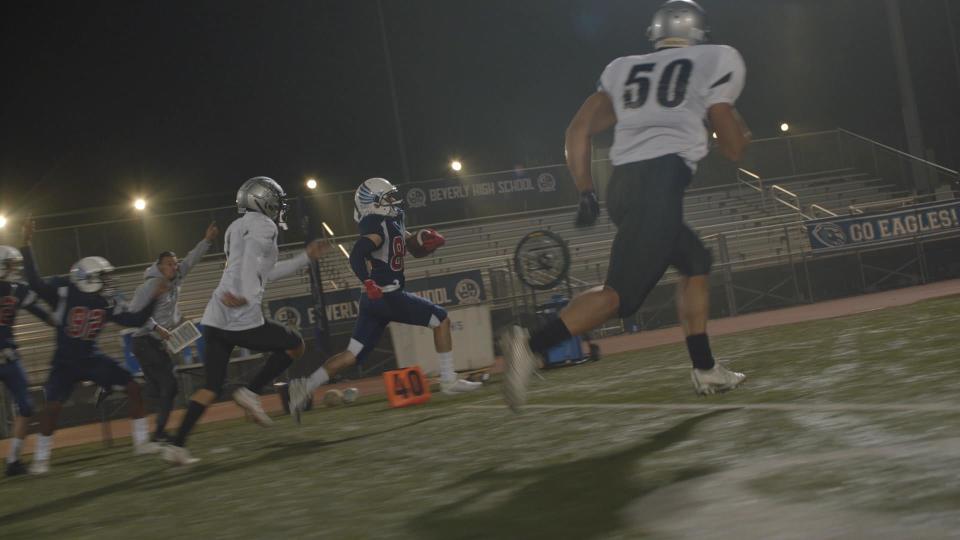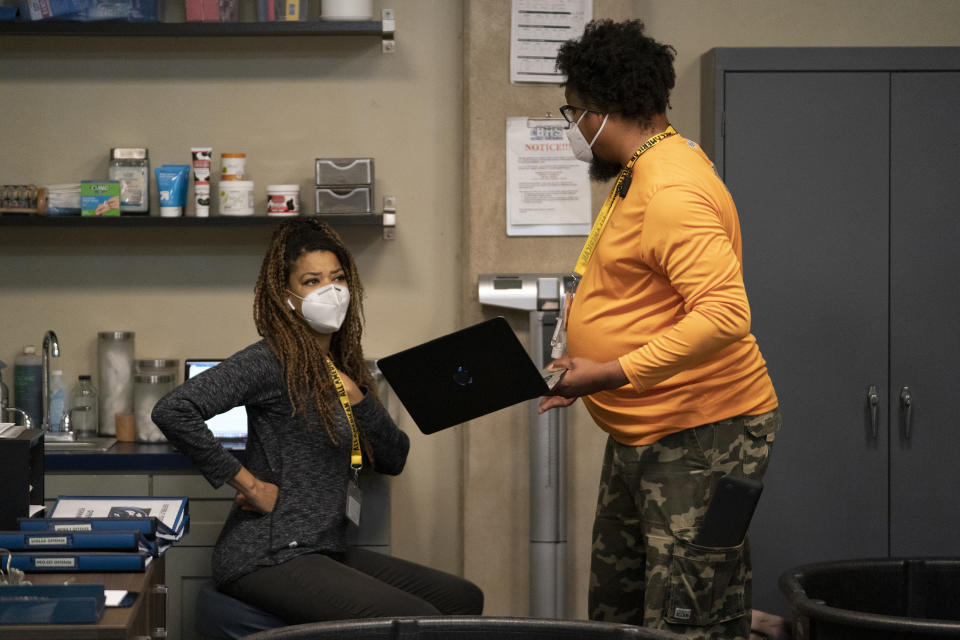How ‘All American’ Season 3 Is Adjusting Its Story and Production Amid the COVID-19 Pandemic (EXCLUSIVE)

Former NFL linebacker Spencer Paysinger’s senior year in high school as the captain of the Beverly Hills High School football team was an essential one to kick-start his professional football career. Since that time in his life was never dramatically halted by a deadly pandemic, and since the CW’s “All American” is inspired by his life (he is also a co-producer on the drama series), the show won’t be writing COVID-19 into its upcoming third season. But being produced in a time of the coronavirus while not addressing it comes with its own unique challenges.
“The biggest thing is we are a young adult show that loves to throw parties — homecoming, everybody’s birthday — and now it’s just like, ‘Uh uh, what three people are getting together to have coffee and a chat?'” showrunner Nkechi Okoro Carroll tells Variety. “We started writing the season end of February — I rolled directly from Season 2 into Season 3 — so by the time the pandemic hit and it was like it was here to hang out for a while, we went back and did our COVID pass on [scripts] and flagged scenes with too many extras in it.”
For scenes that were originally set at a party or otherwise large social gathering, she shares, it was easy enough to pivot to something smaller because the heart of those were always the private moments between core characters such as Spencer himself (played by Daniel Ezra). Football scenes, on the other hand, took much more planning.
Like almost every production that has resumed amid the pandemic, “All American” has now added a team of Medcor health specialists to their call sheets, including Pete Farrell, a COVID compliance officer, as well as a COVID liaison, a scheduler for COVID testing and an assistant to this new health department. When they are on their soundstage, they also have sanitation specialists who ensure “every horizontal surface and high-contact area” gets thoroughly wiped down at night, and who also use “foggers with a solution approved by WarnerMedia” to spray the inside of all of the trailers, Farrell tells Variety.
Unlike most every other production, though, “All American” block-scheduled its third season so that all of the football scenes from the first half of the season could be shot over one period of time, with its football players, coaches and specialists quarantining for a full two weeks in a hotel first. (Productions that have resumed in Vancouver have also been following the two-week quarantine rule before filming, as mandated by the Canadian government, but “All American” films in Los Angeles, which as of press time has no such mandate.)
“Football’s full contact; socially distanced football works for drills at practice but not for games and it’s their senior year so it just felt crazy [not to have football] if we weren’t addressing COVID on the show,” Okoro Carroll says. So “effectively what we created was a football bubble, modeled after what the NBA did.”
During the quarantine period, the more than 50 players and experts the show uses to make up the various teams were tested routinely — four days a week, Okoro Carroll says, both during practice and filming. Each person had their own “individual sanitation bag,” she adds, which included sanitizer, as well as multiple masks. One mask was flesh-colored so they could wear it under their helmet while in the scene. “If we caught anything on camera we could paint it out [in post],” she says.
The goal was not to expose anyone to each other when they didn’t have to. This is also why the shots of the crowd watching the games in the third season will no longer feature characters having important conversations, surrounded by extras. “There’s going to be a lot of halftime, on their way to the bathroom conversations this season so we can put them on our stages instead,” Okoro Carroll previews. But the teams won’t be playing in front of empty stands: the show is using extra footage from the crowds in the first two seasons’ games, the showrunner continues, to make it still feel like a regular football season.

Wanting to keep people’s unmasked exposure to each other limited also meant Okoro Carroll told her cast that there would be no improvised hugging or kissing in scenes, and she only included “moments of a hug or a kiss in a script if it was absolutely integral to the storyline.” Anything that breaches a six-foot distance between cast members is considered an “intimate scene” and warrants a rapid COVID test on the day of shooting. “I didn’t want to tell them to do something that as soon as we yell ‘cut’ we tell them not to do. As soon as we yell ‘cut,’ it’s masks up, six feet, separate.”
If it’s a Monday, Wednesday or Thursday and the call sheet for the day is not marked with an intimate scene, the cast and anyone who interacts with the cast on a regular basis, from the director to the script supervisor get PCR COVID testing, says Farrell. Days that have “intimate scenes” require the rapid test, regardless of whether they had a PCR test the day before.
“The PCR takes about two or three days to get results and the rapid tests take about 20 minutes to get results,” Farrell explains. “The PCR test is slightly more accurate, but the rapids give peace of mind.”
Part of his job as “All American’s” COVID compliance officer, Farrell says, is to ensure everyone is showing up for their COVID tests, as well as to make sure everyone is wearing a mask — and properly — and social distancing when on-set. He checks the signage on doors they have newly designated “entrance only” or “exit only” to ensure no one is trying to squeeze through in a cross-traffic way, and he, of course, answers health questions from the cast and crew, as well as takes their complaints and talks to anyone who might be in violation. He also works with the director, assistant director and director of photography when they’re setting up shots to determine, based on the size of the space in which they are filming, how many people can be in the room safely.
Every morning, anyone hoping to report to work on “All American” has to check into an app called Passcard, Farrell shares. “It’s a serious of questions — essentially, ‘Have you experienced any COVID symptoms? Have you been around anybody who has tested positive? Do you live in any kind of group home?’ If you answer ‘yes’ to any of them, it will lock you out and not allow you to come on set,” he says. “If you answer ‘no’ to everything, your phone screen will turn green, and you have to show that when you get to the gate. No one is allowed on set unless they can show that green screen.”
“All American” began production on its third season at the end of September, and did have to pause in October due to a positive test. While Farrell says that he has “been told that we have the power to shut down production” if someone simply isn’t adhering to safety guidelines, “we haven’t even come close to having anybody who was that out of compliance where we would have to say we’re going to shut down.” Shutting down due to the positive test was to ensure there weren’t any other positives “we just don’t know about because we haven’t gotten the results yet,” he says. “We will do a contact tracing to figure out who they were within six feet [from], and we will then send them all to get a rapid test immediately.”
“All American” has since resumed production, with Farrell sharing he normally works 12-14 hour days. Some things, such as lunch, do take longer now because eating is no longer allowed on set. “That has been one of the habits that’s been harder to break because people are so used to just grabbing food quickly and eating on set,” he says. Also gone is the buffet-style catering where people can grab what they want and go. “Now you have to walk up to catering, who has clear shields protecting everybody, and you have to tell them what you want, they fill up your food container and everything is to-go now. The dining area is zoned now, and you can’t sit in big groups anymore.”
Additionally, “there’s far more cleaning going,” Farrell says. “Makeup artists have to clean and sanitize their brushes after each person; they have to soak their brush in alcohol and let it air dry to make sure it kills anything.” High-traffic areas get wiped down multiple times a day, in between takes and setups.
On-set is essential personnel only, which means only one makeup or hair stylist can fly in for a touch=up between takes. And the actors must wear shields now, to protect them and their makeup artists. When they come on set to film, they hand their shields to Farrell’s assistant, who puts them in a bin. She returns them when the scene is wrapped and they leave set.
“We have to wait for the actors to completely clear the set before the grips and electricians and lighting can come in and adjust whatever they have to adjust,” Farrell says.

In order to keep production days from ballooning out into too much overtime, though, Okoro Carroll shares she has been taking a harder look at her scripts and making sure they top out at 46 to 48 pages. “We cannot afford to shoot anything that’s going to end up on the cutting room floor. Crew is in full PPE all the time, they don’t need to spend an extra two-and-a-half hours in PPE,” she explains.
Although the reason for all of these changes has been horrific, with Los Angeles still reporting thousands of new COVID-19 cases a day, both Farrell and Okoro Carroll admit there have been some changes made for the better, and which they hope stick around even once there is a vaccine and some parts of production return to pre-pandemic ways.
The extra cleaning, including having hand-washing stations installed on set, is a good long-term idea, as are the masks and shields, says Farrell: “Even if you weren’t in a pandemic, with flu season coming, this would cut down on the transmission.”
Okoro Carroll seconds the idea of extra hygiene stations but also adds, “The kind of collaborations and thinking outside of the box that we’re seeing, the way everyone is working together to make it all happen, this whole idea of working on a production where the No. 1 goal is looking out for each other has been amazing.”
“All American” Season 3 premieres Jan. 18 on the CW.
More from Variety
Best of Variety
Sign up for Variety’s Newsletter. For the latest news, follow us on Facebook, Twitter, and Instagram.

